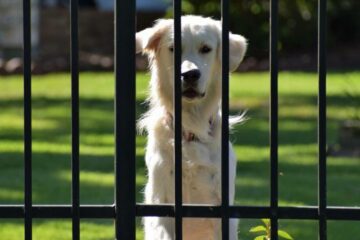Do Beavers Attack Dogs? How to Prevent + What to Do!
Do beavers attack dogs? If you live in an area where these little dam builders are common, you’re going to want to know this info, and better yet, what you can do to prevent beaver attacks on dogs. In this article, we’ll cover all you need to know on both these subjects.
Next, we’ll fill you in on tough but important information such as are beavers dangerous to dogs and what to do in the unfortunate situation that your dog killed a beaver. Finally, we’ll teach you a command to stop your dog barking at beavers, and let you know how to keep beavers away and how to get rid of a beaver dam on your property. Keep reading!
Do Beavers Attack Dogs?

While it is highly uncommon, beavers can potentially attack dogs if they feel threatened. However, they are not typically aggressive creatures and prefer to avoid confrontation when possible. A beaver’s main form of defense is to retreat to the water, but if cornered or defending their young, they might respond with a bite.
Will Beavers Attack Dogs?
Beavers are generally peaceful creatures that keep to themselves. Their primary response to danger is to escape to the safety of water. However, if a beaver is cornered, feels threatened, or is protecting its offspring or territory, it can use its sharp incisor teeth to defend itself.
The Risk of Beaver Attacks
Though the likelihood of a beaver attacking a dog is extremely low, it’s important to be aware that beavers can inflict severe bites if provoked. These creatures have strong jaws and sharp teeth capable of cutting down trees, and a bite can cause significant injury to a dog.
Preventing Encounters With Beavers
The best way to keep your dog safe from potential beaver attacks is to prevent any encounters. Avoid areas known to be inhabited by beavers, particularly those with visible beaver dams or lodges. If you live near a body of water where beavers are present, it is best to keep your dog leashed and under close supervision.
What to Do If Your Dog Encounters a Beaver
If your dog does encounter a beaver, it is important to maintain control of your pet. Do not allow your dog to approach or chase the beaver, as this can provoke an attack. If your dog is bitten by a beaver, seek immediate veterinary care, as the bite may require cleaning, suturing, and antibiotics to prevent infection.
These steps will get your dog to keep away from beavers, but it’s important to remember that the underlying behavioral issues (prey drive, anxiety, overexcitement, etc.) that were causing all of this to begin with will still be present. And until you address those, any positive changes you see are only going to be temporary.
“Well, how do I make these changes last?”
By getting your dog to truly choose to follow your direction, that’s how. I tried many times to write out how you can do this before deciding it made more sense to just link you to the free video series that explains it better than I’d ever be able to.
The series is by a man named Dan who is one of the world’s leading dog obedience trainers. In it, he teaches you how to put an end to things like when your dog doesn’t keep away from beavers and all other misbehavior using his fast and easy-to-follow methods.
In the first video, Dan will reveal to you why the two most common methods of dog training only doom you to failure. You can watch the video now by clicking here. Follow the proven system he’ll show you in his series and you’ll never have to spend another second worrying about your dog not keeping away from beavers ever again!
Are Beavers Dangerous to Dogs?

Beavers are not dangerous to dogs typically, but there can be risks involved if a dog disturbs a beaver, especially one that’s protecting its territory or young. The hazards include potential biting or scratching incidents and transmission of diseases like rabies or giardiasis.
- Disease Transmission: Beavers are known to carry diseases such as rabies and giardiasis, which is also often referred to as “beaver fever”. Although instances are rare, it is possible for a dog to contract these diseases. Transmission could occur through a beaver bite or scratch, or even indirectly through drinking water that a beaver has contaminated.
- Understand Beaver Behavior: Beavers, generally, are not aggressive animals. They are mostly gentle and keep to themselves. However, as with most wild animals, if they feel threatened or if they are in a situation where they need to protect their young or their territory, they can exhibit defensive behavior. A dog that unknowingly wanders into a beaver’s territory could incite a defensive reaction from the beaver.
- Physical Threats: Beavers are equipped with strong teeth and claws that they primarily use for foraging and building. However, when provoked or cornered, they can use these tools defensively. A bite or a scratch from a beaver can result in significant injuries, and it’s of utmost importance to avoid any direct interactions between a dog and a beaver.
- Keep a Safe Distance: If you live in an area where beavers are known to inhabit, it’s important to train your dog to maintain a safe distance from these creatures. This is particularly crucial when you’re near bodies of water, which are typically inhabited by beavers. Learn more about this in the first section.
- Consult a Vet: If you know or suspect that your dog has come into contact with a beaver, it’s essential to consult with a vet, even if there is no visible harm or immediate signs of illness. This can help ensure that your pet hasn’t contracted any diseases and if needed, treatment can be started promptly.
In summary, while beavers are not dangerous to dogs inherently, any interactions between them can indeed pose some risks. These include potential disease transmission, understanding of beaver behavior, recognition of the physical threats, need to maintain a safe distance (learn this in the first section), and requirement of vet consultation following any encounters.
It’s very important to take care of your dog’s problems dealing with wildlife now. Handling their issue with beavers will also allow for safe encounters with other animals. You’ll know that coming across your dog with rabbits, your dog with groundhogs, your dog with badgers, your dog with raccoons, or your dog with possums is nothing to fear.
My Dog Killed a Beaver
If your dog killed a beaver, it’s critical to first ensure your dog is unharmed, then notify local wildlife authorities. Despite their mostly docile nature, beavers can carry diseases that could potentially be transferred to your pet. Avoiding such incidents in the future is best achieved through training and supervision.
Checking Your Dog’s Health
First, ensure that your dog is not injured. Beavers have strong teeth and can inflict serious wounds. If your dog has been bitten, seek immediate veterinary care. Also, monitor your dog for signs of disease transmission, as beavers can carry parasites or zoonotic diseases.
Contacting Local Wildlife Authorities
Next, contact your local wildlife authority. They need to know about wildlife fatalities and can provide advice on how to handle the situation. They may ask you questions about the event, so try to provide as much information as you can.
Understanding the Reason for the Attack
If your dog killed a beaver, it may be due to their natural predatory instincts, particularly if they are a breed with high prey drive. However, it could also be a result of the beaver acting defensively if it felt cornered or threatened.
Preventing Future Incidents
To prevent future incidents, avoid known beaver habitats, especially during their active periods around dawn and dusk. Always supervise your dog around wildlife. If your dog has a strong prey drive, you’ll likely need further training to control their underlying impulses. We explain how to do this in the first section.
Training Your Dog to Avoid Wildlife
Training your dog to avoid wildlife is essential for their safety and the safety of the animals. Start with basic commands like “leave it” and “come”. You may also have underlying behavioral issues which will complicate matters. Learn how to handle these in the first section.
In conclusion, if your dog killed a beaver, first ensure your pet’s safety and health, then notify local wildlife authorities. Prevention is the best course of action, achieved through careful supervision and training your dog to avoid wildlife.
How to Stop Dog Barking at Beavers
To stop a dog from barking at beavers, a combination of training commands, distraction techniques, and ensuring a safe distance should be employed. In particular, teaching your dog the ‘quiet’ command can be especially helpful.
- Teach the ‘Quiet’ Command: Training your dog to understand the ‘quiet’ command can be incredibly helpful in managing their barking behavior. Start this training in a quiet environment, progress gradually to more distracting environments, and finally practice in real-life situations when beavers are present. Always remember to reward your dog when they obey the command.
- Use Distractions: Distraction techniques can be very effective. When a dog is focused on a beaver, distracting them with their favorite toy, treat, or activity can break their focus and stop the barking. It’s essential to introduce the distraction before your dog starts barking to prevent reinforcement of the barking behavior.
- Maintain a Safe Distance: Keeping your dog at a safe distance from beavers can reduce the likelihood of them barking. If your dog starts barking at the sight of a beaver, try to calmly lead them away until they’re at a distance where they can remain calm. Learn more about this in the first section.
- Positive Reinforcement: Always reward your dog for good behavior. If they stop barking on command or don’t react to the sight of a beaver, provide them with a reward such as a treat or their favorite toy. This reinforces the positive behavior.
- Address Underlying Issues: If the barking behavior continues, your dog likely has an underlying behavioral issue that is stopping you from making progress. Go back to the first section now and we’ll teach you how you can deal with these.
In summary, stopping a dog from barking at beavers involves a combination of training commands, distraction techniques, and maintaining a safe distance from the animal. Always remember that positive reinforcement goes a long way, and to address underlying issues if needed.
How to Keep Beavers Away
To keep beavers away from your property, employ strategies like installing barriers, using repellents, and managing the surrounding vegetation. Incorporating these preventative measures can deter beavers from building structures or causing damage to your land.
- Install Barriers: Physical barriers such as fences or mesh wiring can prevent beavers from gaining access to your property. Ensure the barriers are sturdy and deep enough to stop beavers from burrowing under.
- Use Repellents: Various beaver-specific repellents are available on the market. These usually have a scent that beavers find unappealing, deterring them from your property. It’s crucial to apply the repellent regularly, especially after rainfall, for it to be effective.
- Manage Vegetation: Beavers are attracted to certain types of trees and vegetation. By managing and reducing these plant species on your property, you can make your land less appealing to beavers. Incorporating plants they don’t like can also act as a natural deterrent.
- Install Protective Devices on Trees: Wrap your trees with wire mesh or install tree guards to protect them from beavers. Beavers are primarily attracted to trees for food and building materials, so protecting your trees can be a significant deterrent.
- Professional Animal Control: If the beaver problem persists, consider consulting a professional animal control service. They can offer solutions tailored to your specific situation and ensure the humane handling of the animals.
In summary, keeping beavers away from your property involves installing barriers, using repellents, managing vegetation, and protecting your trees. If these methods prove ineffective, seek professional animal control assistance. Always remember, the aim should be to deter beavers humanely without causing them harm.
How to Get Rid of a Beaver Dam
To get rid of a beaver dam, the first steps are determining the legality in your area and then considering non-lethal methods. Remember that beavers play a critical role in their ecosystem, so consider professional help. If removal is necessary and legal, proceed cautiously and in a way that causes minimal harm to the beaver population.
Is It Legal to Remove a Beaver Dam?
Before attempting to remove a beaver dam, it’s essential to check local and national laws. In many regions, beavers are protected species, and their dams cannot be legally destroyed without permission from wildlife authorities. Always seek advice from your local wildlife agency or a professional wildlife control company.
The Role of Beavers in the Ecosystem
Beavers play a crucial role in maintaining the ecosystem. Their dams create wetland habitats that support a wide array of wildlife. These wetlands also filter and clean water, recharge aquifers, and control the flow of water, reducing the risk of floods downstream.
Non-Lethal Methods to Manage Beaver Dams
Consider non-lethal methods for managing beaver dams. Techniques include installing pond levelers, pipes, or exclusion fences to regulate water levels or exclude beavers from certain areas. Professional wildlife control companies can provide these services and ensure minimal disruption to the beavers and their habitat.
How to Remove a Beaver Dam
If removal is necessary and legal, proceed with caution. Begin by removing small sections of the dam each day. This gradual process will cause less stress for the beavers and the ecosystem, and the beavers may even decide to move on their own. Always monitor the situation closely and halt the process if it appears to be causing undue harm.
Getting Professional Help
Hiring a professional wildlife control company is the safest option for both you and the beavers. They have the necessary experience and equipment to handle the job in a humane and eco-friendly manner.
In summary, while it might be tempting to remove a beaver dam if it’s causing problems, it’s important to respect the vital role beavers play in the ecosystem. Always check the legality of removal in your area and consider professional assistance to handle the situation with the utmost care.
I’m sure you’re ready for worry-free nature walks, so I’ll let you get going on things now. Best wishes with everything, and thank you for checking out our article “Do Beavers Attack Dogs? How to Prevent + What to Do!”





